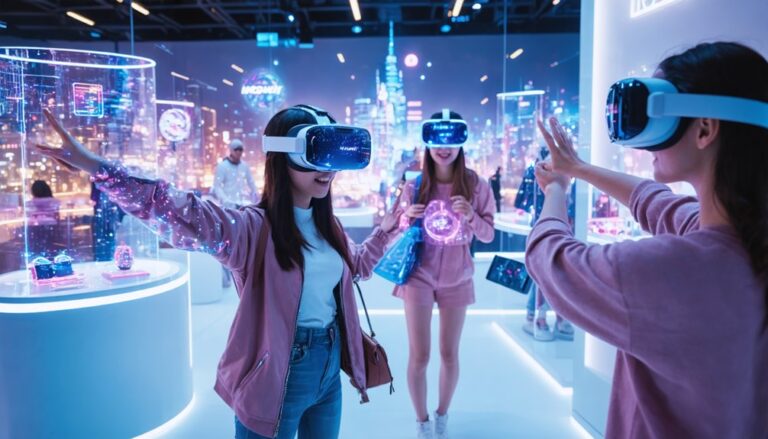Virtual reality shopping is positioned to revolutionize e-commerce by creating immersive experiences that enhance consumer engagement and purchasing confidence. With a market projected to expand to $2.5 billion by 2025 and a 25% CAGR until 2033, retailers are rapidly investing in AR and VR technologies. As consumer preferences shift towards these innovative platforms, the industry stands on the brink of significant metamorphosis. This evolution hints at exciting developments in how shopping will be experienced in the near future.
Highlights
- Virtual reality shopping is projected to reach $2.5 billion by 2025, indicating rapid growth in the e-commerce sector.
- Nearly 80% of retailers plan to adopt AR/VR solutions to enhance customer experiences by 2025.
- Gen Z consumers show a strong preference for AR tools, with 92% favoring immersive shopping experiences.
- Seamless digital payments and AI-powered assistants are transforming the shopping experience in virtual environments.
- The metaverse retail market is forecasted to reach $1,561.7 billion by 2034, highlighting vast future potential.
The Rise of Virtual Reality in Retail
The rise of virtual reality (VR) in retail signifies a revolutionary shift in how consumers engage with products and brands. Through immersive experiences, virtual stores transform traditional shopping into an interactive excursion, allowing customers to visualize and personalize purchases like never before. Innovations such as the IKEA Place app and Audi’s VR Car Configurator enhance confidence in buying by enabling realistic product placements and customizations. Additionally, social shopping platforms, such as Alibaba’s Buy+, nurture a sense of community, allowing friends to shop together in a shared virtual environment. As brands utilize VR’s potential, they not only enhance consumer convenience but also cultivate deeper emotional connections, solidifying loyalty and driving engagement in this evolving landscape of retail innovation. Moreover, global accessibility is a significant advantage of VR, enabling brands to connect with customers across borders and enhance shopping experiences for a diverse audience. Furthermore, VR technology is being used by retailers to improve employee training and customer service interactions, highlighting its far-reaching applications in the retail space. VR retail market share is rapidly growing, with VR head-mounted sets accounting for 62% of the market in 2023.
Market Growth and Projections
As the scenery of retail increasingly envelops virtual reality, significant market growth and promising projections stand out. The virtual reality shopping market is estimated to reach $2.5 billion by 2025, with a sturdy CAGR of 25% predicted until 2033. Market analysis indicates that the broader VR domain could expand from $44.4 billion in 2025 to an impressive $284.04 billion by 2034. Key growth strategies involve enhancing user engagement through semi-immersive and fully immersive experiences, particularly in retail. North America leads with a 35.53% market share, while the Asia Pacific region, driven by rising internet penetration and an emboldened consumer base, is set for considerable expansion. Moreover, the rise of haptic feedback technology is driving growth by creating more realistic virtual environments. Additionally, the metaverse retail market is projected to reach USD 1,561.7 Bn by 2034, highlighting the expansive potential of this sector. Furthermore, the virtual reality market’s substantial growth forecast underscores its projected CAGR of 22.9% from 2025 to 2034. The future shines brightly for innovative retail environments and immersive shopping experiences.
Consumer Adoption and Preferences
Consumer adoption of virtual reality (VR) shopping is rapidly developing, driven by an intersection of technological advancements and shifting consumer preferences. Social trends highlight that nearly 60% of the U.S. population engages with augmented reality (AR), with over 90% of shoppers open to integrating it into their buying experiences. This enthusiasm is particularly pronounced among younger demographics, where 92% of Gen Z consumers favor AR tools for e-commerce. Personal preferences lean toward immersive experiences, such as virtual try-ons, which have gained traction, evidenced by a 200% increase in adoption since 2023. As AR enhances the shopping path and influences purchase decisions, it reshapes how consumers engage with brands, nurturing a sense of community and belonging in digital marketplaces. Moreover, AR drives conversion and reduces returns, further accentuating its significance in modern shopping experiences. With consumer spending in the global AR market expected to reach $87.3 billion by 2025, this integration is likely to become even more influential in shaping e-commerce strategies. Additionally, the global augmented reality (AR) and VR headset market is expected to ship 28.7 million units by 2025, underscoring the increasing enthusiasm for these technologies among consumers.
Retailer Investments and Strategies
An era of innovation has emerged as retailers increasingly prioritize investments in virtual reality (VR) and augmented reality (AR) technologies to enhance customer experiences. With projections suggesting the VR retail market could grow to $6.82 billion by 2025, retailers are strategically forging retail partnerships with AR/VR technology providers. Approximately 80% of retailers plan to incorporate these solutions into their customer experience strategies by 2025, reflecting a commitment to vigorous investment strategies. Focus areas include 3D content creation and immersive shopping platforms that bridge in-store and online experiences, thereby nurturing customer engagement. As the market dynamics shift, sectors such as fashion and automotive lead the way, underlining the importance of adaptive investments in immersive technologies for connection-driven shopping experiences, characterized by a vibrant market environment. This is particularly evident as the global VR market is projected to reach $49.11 billion by 2033, highlighting the long-term potential of these investments.
Impact on Consumer Behavior and Conversion Rates
While the integration of virtual reality (VR) shopping continues to gain momentum, its profound influence on consumer behavior and conversion rates is becoming increasingly evident.
VR is transforming shopping habits by creating immersive experiences that promote stronger emotional connections with brands.
Consumers are more engaged when visualizing products in customized environments, which substantially impacts their buying decisions.
Enhanced product understanding through virtual try-ons and room visualizations reduces cart abandonment, consequently boosting conversion rates.
As shoppers welcome social VR experiences, they find belonging in shared explorations, enhancing overall satisfaction.
The data-driven perspectives gained from these interactions allow retailers to refine offerings adaptably, ensuring that consumer preferences are met, culminating in improved purchase intent and repeat engagement.
Technology and Experience Types
As virtual and augmented reality technologies continue to evolve, the scenery of shopping is being enhanced by diverse experiences customized to modern consumer needs.
AR technology facilitates customer engagement through markerless applications that allow users to visualize products in their own environments, such as furniture placement in homes.
Meanwhile, virtual showrooms provide immersive 3D environments that replicate physical stores, enabling customers to delve products interactively.
These technologies blend digital and physical realities, enhancing the shopping experience.
Additionally, location-based AR can augment customer interaction by directing them to promotions based on their geographic position.
Future Trends in VR Shopping
The future of virtual reality shopping is ready for revolutionary growth, driven by advancements in technology and shifting consumer behaviors that will revolutionize the e-commerce scenery.
With nearly 60% of Americans expected to accept AR/VR by 2025, brands must adapt to thrive.
Enhanced social interactions within virtual spaces will promote community engagement, appealing especially to the tech-savvy Gen Z demographic.
Retailers will increasingly integrate seamless digital payments, ensuring frictionless transactions in immersive environments.
Advances such as AI-powered shopping assistants and haptic feedback will personalize experiences, further driving conversion rates.
As businesses adopt virtual showrooms and rely on credible blockchain technology, the shopping experience will shift to prioritizing consumer connection and authenticity, establishing VR as a cornerstone of modern retail.
Conclusion
As virtual reality continues to reshape the terrain of e-commerce, its potential to enhance consumer engagement and satisfaction becomes increasingly evident. With substantial investment from retailers and a clear path toward mass adoption, VR shopping is positioned to redefine the retail experience. By merging immersive technology with personalized experiences, the future of shopping will not only enthrall consumers but also drive significant conversion rates, marking a critical shift in how people interact with brands and make purchasing decisions.
References
- https://www.archivemarketresearch.com/reports/virtual-reality-shopping-55830
- https://www.brandxr.io/2025-augmented-reality-in-retail-e-commerce-research-report
- https://cimulate.ai/digital-commerce-statistics/
- https://www.insightaceanalytic.com/report/metaverse-retail-market/3083
- https://www.g2.com/articles/virtual-reality-statistics
- https://provenreality.com/virtual-reality-retail-experience/
- https://tblocks.com/guides/virtual-reality-in-retail/
- https://fitsmallbusiness.com/virtual-reality-in-retail/
- https://capsulesight.com/vrglasses/15-examples-of-the-use-of-virtual-reality-vr-in-retail/
- https://program-ace.com/blog/virtual-reality-in-retail/




